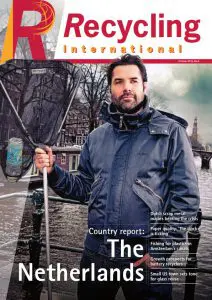Page 52 from: October 2016

what to do, right? Everyone stops. But then you
come across a yellow light. What happens next?
Some will accelerate through.’ With a grin, he
added: ‘And you know who you are.’
His analogy served to show that rules can occa-
sionally be cause for debate and that, most
importantly when it comes to safety, the battery
industry cannot allow people to guess what to do.
‘The same traffic light principle applies to trans-
port guides, which could be described as
a decision tree with many steps, “if ”s and
“or”s,’ it was explained. For the ‘green’ sce-
nario, all types of transportation are safe
for the batteries; for ‘yellow’, some types of
transportation are safe; and for ‘red’, batteries
are unsafe for transportation although there
may be exceptions.
These exceptions are dependent upon vari-
ous factors, ranging from battery weight,
chemistry, preferred means of shipment,
probability of a ‘dangerous reaction’, as well
as special inner and outer packaging criteria.
‘It is a long list,’ Polonius acknowledged.
Pending approval
Various approval solutions
can apply, such as vermicu-
lite plus cooling of the bat-
tery overnight with dry ice
before shipping it inside a
metal box. ‘What we see
is that different industry
players in different coun-
tries often have different
methods of transporting,’ Polonius remarked.
‘This increases the level of uncertainty for all
actors involved.’
He and the Daimler safety crew have seen too
much footage of raging fires onsite to take the
matter of logistics lightly. ‘We have to make
operations easier,’ Polonius affirmed. ‘We want
to get away from the approval process, and go
towards a fixed solution by means of legislation.’
Not only are packaging and shipping terms and
conditions overly complicated, but also they are
accompanied by substantial additional costs,
he contended. ‘Let’s say you want to transport
batteries through more than one country, then
you will have to get more than one approval
Batteries Down Under
In Australia, handheld battery sales totalled AU$ 400 million (US$
304 million) in 2013, including 50% rechargeable and 50% single-
use batteries by weight. By chemistry, the total comprised 49%
single-use alkaline and zinc carbon batteries and 48% rechargeable
lithium-ion and lead-acid batteries.
‘Sadly, the recycling rate currently only stands at roughly 3%,’
revealed Helen Lewis of the Australian Battery Recycling Initiative,
adding that there is ‘not really any co-ordinated national approach’.
However, there are some albeit limited take-back schemes operated
by companies such as Ikea and Aldi.
To up the ante, four collection schemes were launched last year.
In addition to ones for button cells and rechargeable batteries,
a one-year pilot collection scheme for power tool batteries was
launched in Brisbane. The initiative concluded in July and extended
to 2 million people via 19 hardware stores. The project amassed
2 tonnes of batteries, with Lewis concluding that the feasibility of
such a stand-alone scheme has yet to be proven.
A somewhat more unusual take-back scheme called ‘ExitCycle’
centres around emergency lighting in Queensland, delegates were
informed. With 90% of the batteries used in emergency and exit
lighting being of the nickel-cadmium variety, some five million
are consigned to landfill every year – which equates to around 90
tonnes of cadmium. Lewis therefore expressed the hope that the
project would result in the roll-out of a national scheme.
Despite the long journey ahead for battery recycling players in
Australia, Lewis emphasised that ‘we have good momentum and
engagement from a committed few’.
Moreover, industry associations
will shortly make papers available
on funding and governance
options.
Alyona Yuzefovich of Megapolis Resource is fighting an ‘uphill
battle’ to get battery collection off the ground in Russia.
52 October 2016
B A T T E R I E S
Buyers of Ferrous and Non Ferrous Scrap and Secondary Metals
Always in the Market for :
Stainless Steel Scrap
Aluminium Scrap
Secondary Steel Plates & Coils
Sealed Units
HMS & Shredded Scrap in bulk/containers
Electric Motors
Stainless Steel Solids and Turnings (304 & 316)
Aluminium Scrap (Tense, Zorba & Old Sheet)
Catalytic Convertors Scrap 409
Shredder Pickings
Lead Scrap
Cast Iron Scrap
PNS Scrap
Zorba
Insulated Copper Wire
Copper Scrap & Brass Scrap
Call USA offi ce NJ – Jignesh (Jay) @ +1 267 -577 – 5191; Call CT offi ce Bhima @+1 203 – 561 – 3650
Fax: + 1 225 – 410 – 8751 Email: [email protected] Website: www.akjayint.com
India offi ce contact: Jay Email: [email protected] Mobile:+91 9879594191



